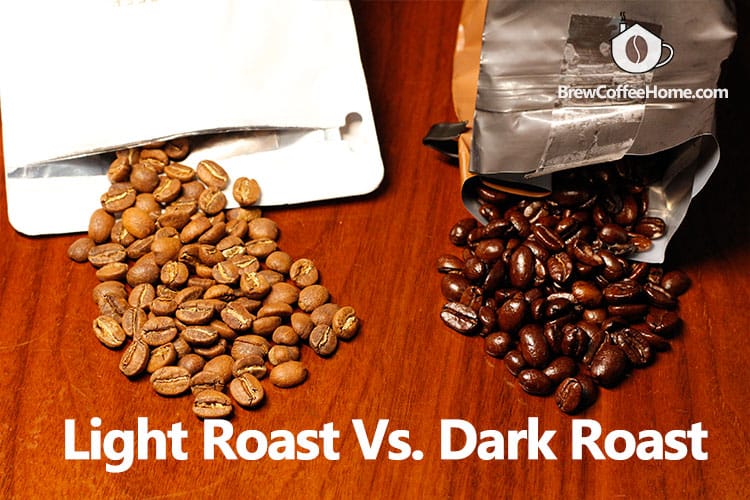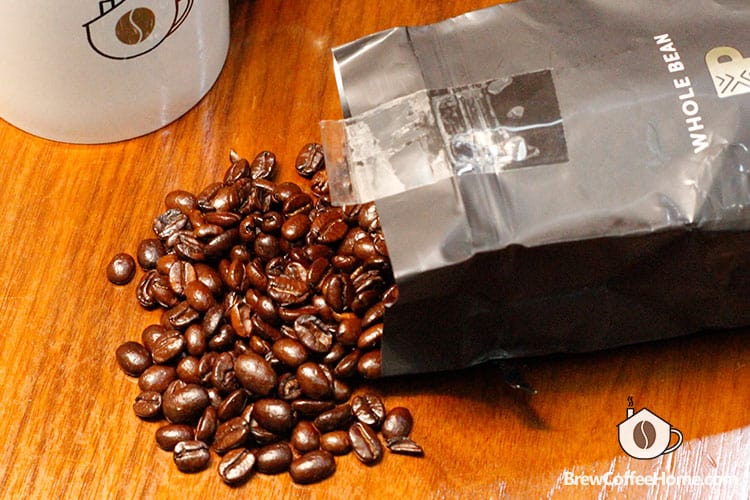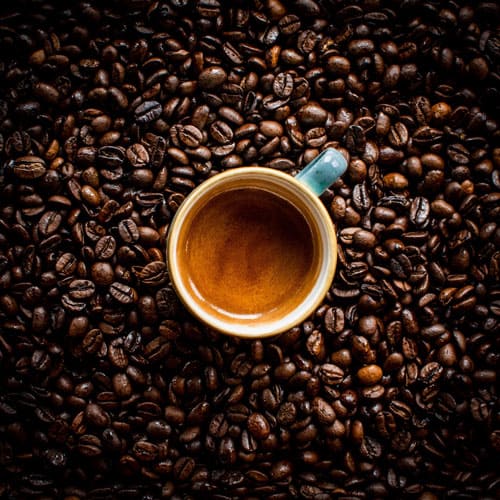Many coffee connoisseurs purchase their coffee in whole bean form instead of ground.
However, whole beans often have an oily or glistening appearance, especially for dark roasted coffee beans. This oil is generally related to the roast level of the coffee. It can also be indicative of their freshness in some cases.
Can you brew great coffee using oily beans? Is it good or bad? Let’s find out.
What Is the Oil on Coffee Beans?
The oil on coffee beans is fat-like lipids – including triacylglycerols, tocopherols, and sterols – that have leached out from the center of the beans during the coffee roasting process. These triacylglycerols and fatty acids are in edible vegetable oils too.
Coffee beans are technically the plant’s seeds. Like many seeds, they contain lipids that provide nutrients to a young and growing plant. These lipids called coffee oil can comprise 7-17 percent of the coffee bean.

Why Are Coffee Beans Oily?
Fresh green coffee beans do not have oil on their surface. The lipids are deep within the endosperm of the beans and only emerge after roasting.
The composition of coffee beans’ cell walls is cellulose, a long chain of sugar molecules that make up cell walls and give wood its strength. The cellulose breaks down during the roasting process and allows the lipids to emerge from the center of the beans.

The lipids coat the bean’s surface and create an oily appearance. Additionally, freshly roasted coffee beans gradually excrete oil over time. Here is a breakdown of what makes an oily coffee bean.
Dark Roast Coffee
Dark roast coffee undergoes a longer roasting duration than its light and medium roast counterparts. The longer the beans roast, the more the cellulose degrades. The beans become more porous and allow more lipids to emerge from the endosperm and coat the exterior of the beans.
Dark roast coffees have the oiliest appearance of the main types of coffee roasts, which is normal. A coffee filter will usually catch these oils before dripping into the liquid, but a brewing method like the french press incorporates the oils into the coffee and creates a full-body taste. An espresso machine extracts the coffee with high pressure, and the oil and micro-bubbles foam a layer of crema.

Stale Coffee Beans
As roasted coffee beans get stale, the coffee oils emerge from the center of the bean and create an oily-like appearance on the beans.
Light and medium roasts generally do not have an oily appearance when fresh, so if you notice them developing a shine after a couple of weeks, they are probably stale.
However, if you leave the roasted beans out for an extended period, those oils that emerge will begin to dry and evaporate. Light and medium roast coffee beans will go from dry-looking to oily and back to dry over time.
Always check the roast date on your coffee beans to determine freshness. Store them in sealed coffee bags or coffee containers, and place them in cool, dry places to prolong the freshness.

Decaf Coffee Beans
Decaf coffee beans can also appear oily.
Decaf coffee beans are a type of bean where the coffee producer removes most caffeine. The roasters decaffeinate the coffee beans by using chemical or natural processes on the green beans before roasting them.
Common decaffeination techniques include using carbon dioxide, chemicals like ethyl acetate, or the Swiss Water Process.
The decaffeination process weakens the internal structure of the coffee and breaks down its organic material. The decaffeination, paired with the subsequent roasting process, creates a porous bean that allows the coffee oils to emerge and coat the surface, making the bean appear oily.
Decaffeinated coffee beans can appear oily regardless of roast type.
Should Coffee Beans Be Oily or Dry?
Both dry and oily beans are normal depending on the roast type, the beans’ freshness, and whether the beans are decaffeinated.
Generally speaking, check the following:

Dark Roast Coffee
These are the types of beans most likely to have an oily sheen. Dark roast coffee has a bold, robust flavor and mouthfeel. Coffee roasters often describe their dark roast coffee beans as having notes of dark chocolate.
Dark roast beans also usually have less caffeine and are light and puffy from losing most of their moisture during the roasting process.
Light and Medium Roast Coffee
Light and medium roast coffee beans generally should not be oily. We roast these beans at a lower temperature, and for a shorter duration so the cellulose does not break down and create a porous surface for the oils to rise.
Light and medium roast coffees have a lighter mouthfeel and nuanced, bright flavors. Coffee roasters often describe some of their light-roast coffee as having citrus, melon, and honeysuckle notes. Light and medium roast coffee beans have more caffeine than dark roast beans.
What’s the Problem With Oily Coffee Beans?
The biggest problem with oily coffee beans is they can clog coffee grinders, especially Burr grinders. The oils from the beans can coat the blades and cause the fine coffee grounds to stick, making the grinder unusable. Over time the oily residue can ruin the device. It takes extra effort to clean a burr grinder if you often grind oily beans.
You should not use oily coffee beans in Superautomatic Espresso Machines. Oily beans can make the bean hopper sticky and prevent the flow of beans into the grinder. The coffee grounds and oils in the grinder of your coffee machine will form a compacted substance that blocks the grinder from working.

Oils can also become rancid over time. If you leave your coffee beans exposed to air, sunlight, or heat, the oils will develop unpleasant flavors that ruin the taste of the coffee.
Finally, oily coffee beans are usually darkly-roasted. This may not be a problem for those who love the flavor of dark roasts, but those looking for a little more nuance or bright flavors in their coffee should look elsewhere.
Should You Buy Oily Coffee Beans?
Oily coffee beans might be a good choice if you prefer dark roast coffee with bold, robust flavors.
Always make sure you buy freshly-roasted beans by checking the roast date on the package. Beans in an airtight, sealed package will last several months after the roast date. Once you open the package and expose the beans to air, they begin to degrade quickly.

You should not purchase light or medium-light coffee beans if they appear oily, as this indicates they are stale.
How To Brew Oily Coffee Beans
There are several brewing methods to get the most out of your oily coffee beans. These include using a coarser grind, an immersion method, or making cold brew coffee.
Make Espresso
Many espresso roasts are dark to medium-dark roasts. Those oily beans usually produce more crema and a heavier mouthfeel for your espresso shots.

Coarse Grind
Use a coarse grind for oily beans, no matter the brewing method. Grind coffee beans close to the consistency of sea salt. This helps extract some bold flavors without making the coffee too strong.
Immersion Method
An immersion method like a french press is an excellent choice for oily coffee beans. Without a filter to catch the oils, the brewing process creates a cup of coffee with a full-bodied, creamy mouthfeel. With a french press, you will use a coarse grind and steep the coffee for a shorter duration.
Cold Brew Coffee
Cold brew is another good choice for oily coffee beans. Using cool water in the brewing process helps mask some of the harsher flavor notes in the dark roast beans while drawing out the more pleasant favors.
How To Keep Coffee From Getting Oily
While it is natural for most dark roast coffee beans to be oily, there are some steps you can take to prevent other types of beans from becoming oily.
These steps are to maintain the freshness of the beans:
- Store beans in an airtight container
- Store the beans in a cool, dry place
- Keep the beans away from heat sources like the oven or stovetop
- Keep the beans away from sunlight
- Use the beans soon after opening
Can You Dry Oily Coffee Beans
There is no practical way to dry oily coffee beans, and it is normal for dark roast beans to be oily. Paper filters do an excellent job of catching the oils during brewing. The immersion method will incorporate those oils into the brew and create a robust, full-bodied cup of coffee.
If your light or medium roast beans have turned oily because they’re stale, you can try using the cold brew method to mask some unpleasant flavors.
You also might want to consider throwing them away. After all, who wants to drink old coffee?
Conclusion
Dark roast coffee beans are usually oily – and that’s ok. Those oils are naturally occurring substances that emerge from the bean’s center during roasting. Dark roast, oily coffee beans create bold, robust, chocolatey flavors and a heavy mouthfeel with thick crema.
Medium and light-roasted coffee beans should not be oily. If they start getting an oily surface, they are likely stale.
If you like the bold flavors of oily dark roast coffee beans, remember they can be problematic in burr grinders and are not a good choice for superautomatic espresso machines.
